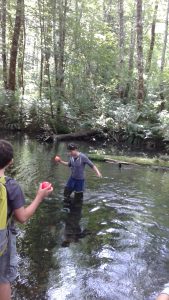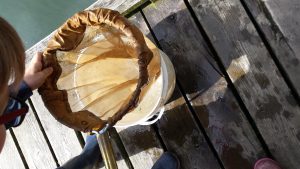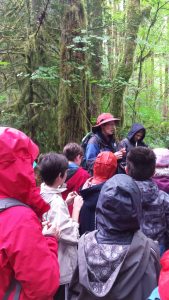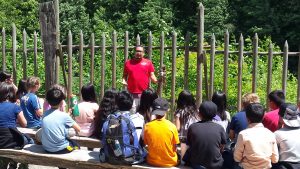Overview
I had the privilege of working at the Cheakamus Centre in Paradise Valley, Squamish, for the duration of my community field experience. I grew up in North Vancouver, so I had attended this unique school in grades 3, 4 and 6, and returning to this place through the lens of a teacher was fascinating. Owned by the North Vancouver School District, this facility offers experiential education to elementary and secondary students across the Lower Mainland. The programs include place-based and hands-on learning of Squamish culture and environmental studies. To learn more about the different programs offered by this unique school, visit http://www.cheakamuscentre.ca/.

Knee deep in learning, loving every moment!
Teaching Experience
I assisted and led various field studies at the Cheakamus Centre. I absolutely loved my time as a teacher in this place, and here are my reasons why:
1. Our lessons were grounded in place using real components of the environment.
The squeals of students in the “Two-Minute Challenge”, sticking their hands in stream water in to feel its coldness. The gleeful expressions of vivid interest and disgust at the frozen bodies of adult Chinook salmon. The hushed solemnity of momentarily holding a salmon fry cupped in a student’s hands before releasing it to the stream. The fervent hunt for bones in a “salmon graveyard” created by eagles in the prior spawning season. Inspecting curious-looking pond creatures through magnifying lenses. These are all examples of students engaging with the real environment in exciting ways that are memorable.

Searching for evidence of pond life.
2. Multimodal approaches to teaching are inherent in outdoor learning.
I taught mainly grade 2 and 3 classes during my time at this centre, so most of the lessons were based on sensory exploration of the environment. Our forest studies oriented towards students using their sense of sight, smell, hearing, and touch, but avoiding taste for safety reasons. Students would closely examine a forest patch for biodiversity, using touch, sight and smell to determine the number and type of species they could find in one small section. We would guide students through sound mapping, in which they would listen closely to the sounds of the forest and record them visually on a piece of paper. Such education takes concepts out of the abstract into the literal realm, where understanding can be more deeply rooted through multimodal ways of learning.

Learning about First Nations use of scouring rushes for sanding and making whistles.
2. Students learn how their actions can affect nature.
The pedagogy of the field studies oriented towards teaching students not only components of ecological systems, but also the human placement within it. How this concept was taught depended on the age of the students due to the philosophy of “no tragedy before eight”. Generating true interest in nature means that younger children need to be given a chance to enjoy it before they are confronted with fear that comes with the problems of global conservation. However, all students could learn about the effects of their personal actions in the forest. With so many schools passing through the centre every year, the educators must be vigilant about teaching the importance of leaving matter in the forest, dead or alive. A good example of this teaching is the salmon mystery game, in which students have to figure out the connections between salmon, eagles, bears, and cedar trees. The major takeaway from this lesson is that salmon fed all the others, though students often did not understand immediately how the cedar was part of the system. The cedar tree absorbs salmon remnants that become part of the soil, and so students learned that even bones needed to put back where they were left by eagles.
3. Students learn to appreciate nature and love being outdoors in their environment.
“Knowledge without love will not stick. But if love comes first, knowledge is sure to follow.” – John Burroughs
I can’t remember how many times I heard students enthusiastically comment on how much they loved being at outdoor school. What is there to dislike about a gigantic sleepover and playing in the woods with all your friends? In this age of close supervision, however, most children are venturing into nature less than in previous generations. If we want future adults to conserve the environment, we must allow children to experience and connect to nature. Only a true interest in the land itself can begin and sustain conversations on human impact.
4. Students learn First Nations culture through role play guided by Squamish nation community members.
The Skw’une-was Program is an immersive experience of First Nations culture that I wish all students in British Columbia could experience. Students sleep overnight in a Bighouse, role-playing various activities, foods, and ceremonies of Squamish culture. The whole experience is guided by members of the nation, making it an authentic learning of the culture by those who know it best. I know this program is effective because I participated myself when I was in grade 4, and I still have vivid memories of roasting bannock and finding lemon-grass to flavor salmon as part of the Hunter-Gatherer clan. The new BC curriculum pushes for fuller integration of First Nations content into all aspects of public education, and I can think of no better way to teach First Nations content.

The goodbye ceremony sharing traditional stories and best memories of the program.
Resource Development
In collaboration with Elizabeth Elston, a fellow student teacher from UBC, I took part in developing teaching resources for use by visiting teachers. There is a boardwalk trail that is underused at present because there is a lack of activities on-hand for specific areas, making it difficult for teachers new to the area to plan their lesson. Elizabeth and I worked together to survey the area and brainstorm educational activities appropriate to the place and curriculum. This planning work was a fun, creative vent for ways we would envision teaching environmental studies, and I am excited for the possibility of having a lasting legacy that can be used by the many teachers who enroll their classes in outdoor school.
Curious what we came up with? Here is a break-down of the possible activities we came up with for the trail:
